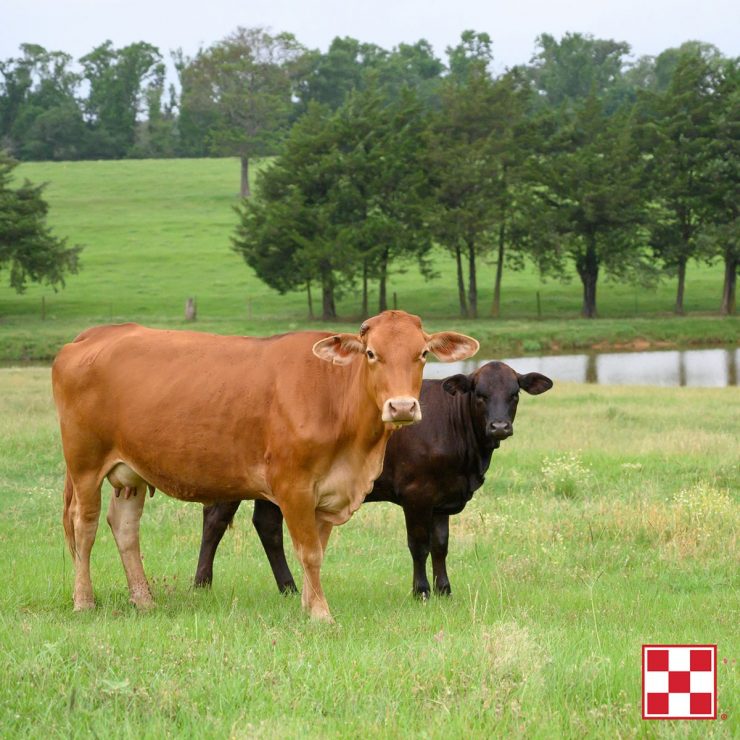Focus on replacement heifer development for more productive cows
Replacement heifer nutrition and management can impact your cow herd for generations.
Think of the most valuable cows in your herd. What makes them stand out?
They probably…
- Stay in good body condition
- Breed back early in the breeding season
- Calve without difficulty
- Wean a heavy, healthy calf…
and they do it all consistently, staying in the herd for many years as a profitable cow. But, let’s take it back a life stage. Your most valuable and productive cows all started as replacement heifers. Set heifers up for long-term success in the cow herd with these tips:
Select the right replacements
Use visual appraisal. Look for fertile, easy-fleshing females. A heifer that’s easy-fleshing stays in good body condition score (BCS), and if she stays in good BCS, she has better odds of getting bred earlier.
Identify older heifers. Older heifers are typically the offspring of cows that calved early in the breeding season, which can imply that those heifers are fertile like their dams.
Refer to calving records. Without records, we tend to select heifers that are bigger, not necessarily older. If large heifers are consistently selected as replacements, you might end up with cows that are too big for their environment. Large cows can also require more supplemental feed to breed back promptly and raise their calves.
Take reproductive tract scores 45 days before breeding. Work with a veterinarian to score reproductive tracts. Cull the heifers scoring below a 3 on the 1 (immature or infertile) to 5 (cycling) scoring scale. Heifers that score a 4 or 5 are ideal replacement heifers.
Set heifers up for success
Target proper weights. Once you select your replacements, aim for them to reach 60-65% of their mature weight at breeding (around 14-15 months of age). Research has shown you could sacrifice conception rates and longevity if heifers are below 55% of mature weight at breeding.1
Monitor growth rates. Heifers should grow 1.25-1.5 pounds per head per day from weaning until first breeding to meet target weights. Monitor heifer weights to ensure they’re on track.
Provide nutrition to hit growth rates. Select high-energy nutrition, like Purina® Accuration® supplements with Intake Modifying Technology®, to complement your forages and help provide predictable intake that delivers targeted gains. Depending on weather and forage conditions, spring-born heifers require 4-8 pounds of supplemental nutrition per day.
Don’t forget about mineral. Offer Purina® Wind and Rain® Mineral year-round to build mineral reserves ahead of high mineral requirements during pregnancy and at calving.
Choose the right environment. Develop heifers in the same environment that they’re going to work in as productive cows. If you have pasture and forage available to develop heifers, that’s the way to go.
Consider breeding heifers earlier. Heifers then get 20 to 30 days extra to come back into estrus and breed back with the mature cow herd.
Focus on nutrition during the first pregnancy
Maintain high-quality nutrition. Bred heifers have increasing nutritional needs throughout gestation. They’re eating to nourish a fetus and to grow to 85% of their mature weight by first calving. Continue offering supplemental nutrition, like Accuration® Liquid supplement or Accuration® Range Supplements, designed to match bred heifer requirements with changing forage conditions.
Keep your eye on shifting targets. Target heifers to be around 85% of their mature weight and in a BCS 6 at calving. Score heifers 90 days before calving to allow adequate time to help heifers add body condition if needed. Research shows heifers in proper BCS at calving have optimized rebreeding success. Conversely, heifers with inadequate body condition at calving can have a 24% reduction in rebreeding success.2
Develop a customized replacement heifer nutrition program at Kissimmee Valley Feed.
Article brought to you by N.T. Cosby, Ph.D., Senior Cattle Nutritionist, Purina Animal Nutrition




